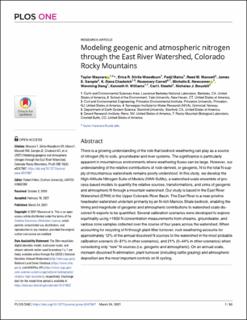| dc.contributor.author | Maavara, Taylor | |
| dc.contributor.author | Siirila-Woodburn, Erica R. | |
| dc.contributor.author | Maina, Fadji | |
| dc.contributor.author | Maxwell, Reed M. | |
| dc.contributor.author | Sample, James Edward | |
| dc.contributor.author | Chadwick, K. Dana | |
| dc.contributor.author | Carroll, Rosemary | |
| dc.contributor.author | Newcomer, Michelle E. | |
| dc.contributor.author | Dong, Wenming | |
| dc.contributor.author | Williams, Kenneth H. | |
| dc.contributor.author | Steefel, Carl I. | |
| dc.contributor.author | Bouskill, Nicholas J. | |
| dc.date.accessioned | 2022-03-11T09:00:02Z | |
| dc.date.available | 2022-03-11T09:00:02Z | |
| dc.date.created | 2022-02-16T11:07:37Z | |
| dc.date.issued | 2021 | |
| dc.identifier.citation | PLOS ONE. 2021, 16 (3), e0247907. | en_US |
| dc.identifier.issn | 1932-6203 | |
| dc.identifier.uri | https://hdl.handle.net/11250/2984509 | |
| dc.description.abstract | There is a growing understanding of the role that bedrock weathering can play as a source of nitrogen (N) to soils, groundwater and river systems. The significance is particularly apparent in mountainous environments where weathering fluxes can be large. However, our understanding of the relative contributions of rock-derived, or geogenic, N to the total N supply of mountainous watersheds remains poorly understood. In this study, we develop the High-Altitude Nitrogen Suite of Models (HAN-SoMo), a watershed-scale ensemble of process-based models to quantify the relative sources, transformations, and sinks of geogenic and atmospheric N through a mountain watershed. Our study is based in the East River Watershed (ERW) in the Upper Colorado River Basin. The East River is a near-pristine headwater watershed underlain primarily by an N-rich Mancos Shale bedrock, enabling the timing and magnitude of geogenic and atmospheric contributions to watershed scale dissolved N-exports to be quantified. Several calibration scenarios were developed to explore equifinality using >1600 N concentration measurements from streams, groundwater, and vadose zone samples collected over the course of four years across the watershed. When accounting for recycling of N through plant litter turnover, rock weathering accounts for approximately 12% of the annual dissolved N sources to the watershed in the most probable calibration scenario (0–31% in other scenarios), and 21% (0–44% in other scenarios) when considering only “new” N sources (i.e. geogenic and atmospheric). On an annual scale, instream dissolved N elimination, plant turnover (including cattle grazing) and atmospheric deposition are the most important controls on N cycling. | en_US |
| dc.language.iso | eng | en_US |
| dc.publisher | Public Library of Science | en_US |
| dc.rights | Navngivelse 4.0 Internasjonal | * |
| dc.rights.uri | http://creativecommons.org/licenses/by/4.0/deed.no | * |
| dc.title | Modeling geogenic and atmospheric nitrogen through the East River Watershed, Colorado Rocky Mountains | en_US |
| dc.type | Peer reviewed | en_US |
| dc.type | Journal article | en_US |
| dc.description.version | publishedVersion | en_US |
| dc.rights.holder | © 2021 Maavara et al. | en_US |
| dc.source.pagenumber | 30 | en_US |
| dc.source.volume | 16 | en_US |
| dc.source.journal | PLOS ONE | en_US |
| dc.source.issue | 3 | en_US |
| dc.identifier.doi | 10.1371/journal.pone.0247907 | |
| dc.identifier.cristin | 2002218 | |
| dc.source.articlenumber | e0247907 | en_US |
| cristin.ispublished | true | |
| cristin.fulltext | original | |
| cristin.qualitycode | 1 | |

